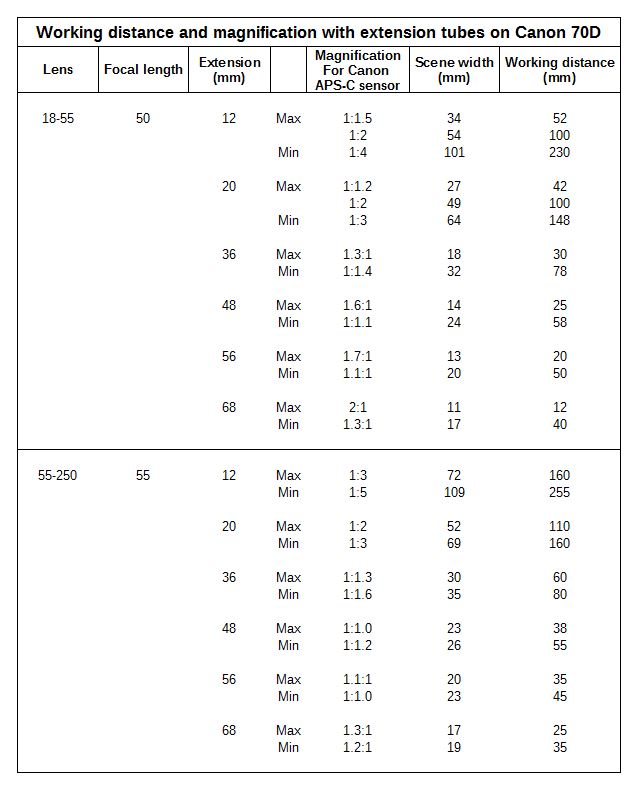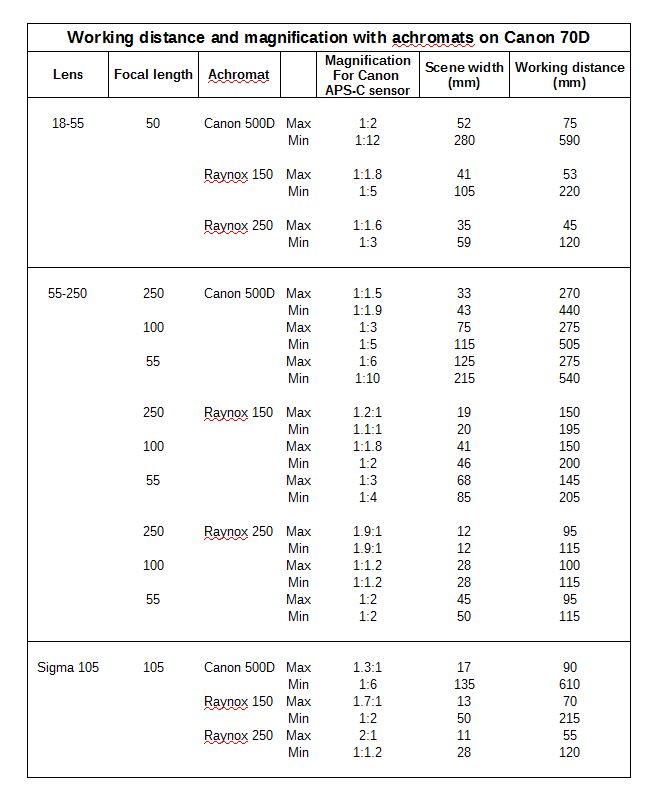Seeing Bryn and Tim's replies, I did a few measurements which I've documented in the tables below.
Notes on some terms used in the tables:
- The "working distance" is the distance from the end of the lens (or filter if you are using one) to the subject.
- "Achromats" are like closeup filters but are made from two or more pieces of glass so as to reduce chromatic aberration. The Raynox 150 mentioned by Bryn is an achromat. I use the Raynox 150 a lot, and also the more powerful Raynox 250 and the less powerful Canon 500D (a closeup lens, not a camera), both of which are also achromats. As well as achromats from Canon and Raynox, achromats from Marumi are quite popular I think.
- All measurements are approximate, especially the smallest distances.
- All magnifications are expressed in terms of Canon APS-C sensors, which are 22.5mm wide, so a scene of width 22.5mm is 1:1, a scene of width 45mm is 1:2 and a scene of width about 11.5mm is 2:1.
- I don't own a 50mm lens, so I had to use my zoom lenses at around 50mm instead.
Extension tubes (see first table below) provide a lot of magnification with shorter focal length lenses, like your 50mm lens, but as Tim says the working distances get quite small. How much magnification you can get, and how small the working distance becomes, depends on how close the lens can focus.
For example, at 55mm focal length my 18-55 lens will focus at a working distance of 110mm. In contrast, at 55mm focal length my 55-250 lens has a minimum working distance of 680mm. This is why, as you can see from the first table, when used with extension tubes the 18-55 can achieve much higher magnifications at 55mm or so than the 55-250 at 55mm. The downside is that the working distances are much smaller.
Tim mentioned losing light. The "effective aperture" of the camera lens gets smaller when you use extension tubes, the more extension you use, the smaller the effective aperture gets (and the less light falls on the sensor). For example, using the 36mm tube may decrease the effective aperture by about a stop so if you set f/16 on the camera you will actually be using an ("effective") aperture of f/22. This means using a longer exposure or a higher ISO if using natural light, and it will also increase the loss of sharpness from diffraction.
Alternatively, you can decrease the aperture set on the camera. For example, if you want to use f/16 but are using 36mm of extension tube, you might set the aperture on the camera to f/11, and the 36mm extension tube will bring the actual ("effective") aperture back to f/16.
Achromats work best with longer focal length lenses. They work particularly well with telezoom lenses. I use my achromats with a 55-250 lens on my Canon 70D and as you can see from the second table you get a reasonable range of magnifications and quite manageable working distances, such as around 100mm working distances at around 2:1 magnification.
Achromats don't change the effective aperture and so they don't lose light and they don't increase the loss of sharpness from diffraction.

0689 01 Working distance and magnification with extension tubes on Canon 70D by
gardenersassistant, on Flickr

0689 02 Working distance and magnification with achromats on Canon 70D by
gardenersassistant, on Flickr

0689 03Minimum working distances on 70D by
gardenersassistant, on Flickr
 8 by urbexcallum, on Flickr
8 by urbexcallum, on Flickr DSC_0090 by urbexcallum, on Flickr
DSC_0090 by urbexcallum, on Flickr DSC_0223 by urbexcallum, on Flickr
DSC_0223 by urbexcallum, on Flickr 8 by urbexcallum, on Flickr
8 by urbexcallum, on Flickr DSC_0090 by urbexcallum, on Flickr
DSC_0090 by urbexcallum, on Flickr DSC_0223 by urbexcallum, on Flickr
DSC_0223 by urbexcallum, on Flickr



